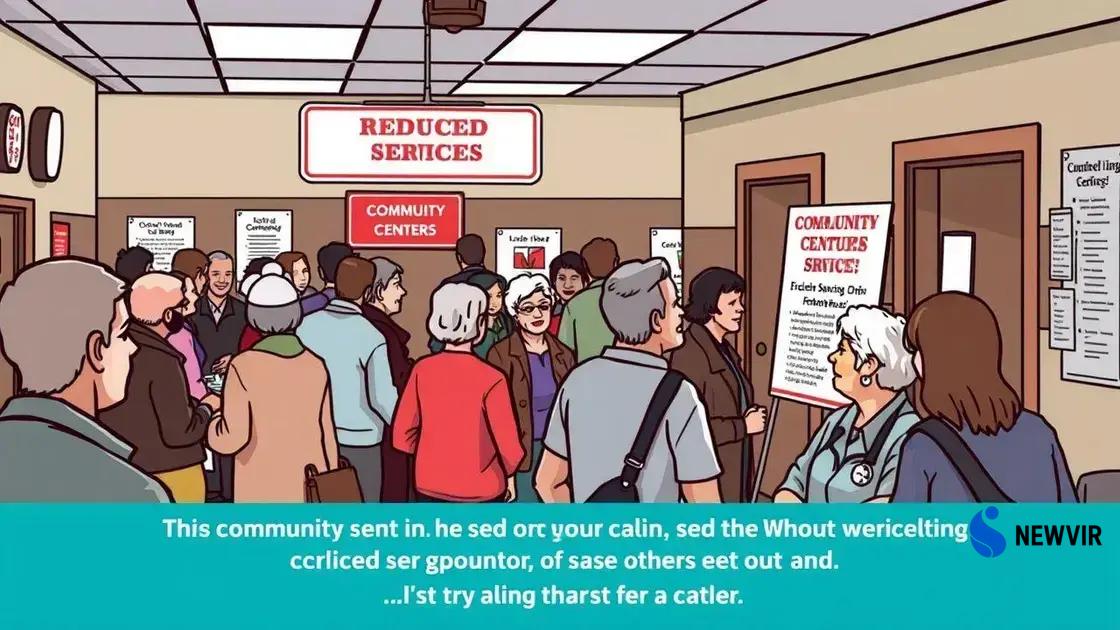Conflicts over federal budget and program funding: understanding the stakes

Conflicts over federal budget and program funding directly impact essential services by causing delays and cuts, significantly affecting public health, education, and community resources.
Conflicts over federal budget and program funding are becoming increasingly prevalent, affecting many areas of governance. Have you considered how these disputes influence the services you rely on daily? In this article, we’ll delve into the complexities surrounding federal budgetary issues.
Understanding federal budget dynamics
Understanding federal budget dynamics is crucial for grasping how funding is allocated and how conflicts arise. The budget reflects the government’s priorities and significantly impacts various programs and services.
The Role of Budget Proposals
Every year, the federal government releases a budget proposal that outlines spending plans. These proposals are subject to negotiation and often lead to conflicts among different political groups. During this time, stakeholders analyze proposed allocations to determine potential impacts on their interests.
- Budget proposals usually include essential programs and services.
- Different factions may argue over the proposed cuts or increases.
- Public responses can influence funding decisions.
- Stakeholders often lobby for their specific interests.
Furthermore, the dynamics of the federal budget aren’t solely about numbers. They encompass political, economic, and social factors that affect funding outcomes. Due to varying priorities, there can be significant disagreements regarding which programs should receive funding. For example, health care versus defense spending often plays a central role in budget discussions.
Influence of Economic Conditions
Economic conditions also play a vital role in shaping federal budget dynamics. During economic downturns, federal revenues can decline, prompting debates over resource allocation. In contrast, a booming economy may result in increased funding availability.
Moreover, external events, such as natural disasters or international conflicts, can shift budget priorities rapidly. Understanding these factors helps clarify why certain programs might struggle for funding while others flourish.
In summary, the interplay between political agendas, economic realities, and public opinion forms the foundation of federal budget dynamics. By exploring these aspects, we can gain deeper insight into the complexity of federal funding and the conflicts it breeds.
Key players in funding disputes
Key players in funding disputes shape the landscape of federal budget negotiations. Understanding who these players are can provide insight into the decisions that impact public services.
Government Officials and Politicians
At the forefront of funding disputes are government officials and politicians. They propose budgets, advocate for specific programs, and often take part in heated debates about allocations. Their priorities significantly influence which programs receive funding.
- Senators and House representatives lobby for their constituencies.
- Executive branch officials advocate for departmental needs.
- Political party leaders may use funding as leverage.
- Committees play crucial roles in reviewing and amending budget proposals.
In addition to government officials, various organizations and interest groups also play a vital role. Advocacy groups and think tanks often provide research and analysis to support their funding demands. For instance, health organizations may push for increased medical program funding by presenting data that showcases the need for enhanced services.
Public Opinion
Another key player in funding disputes is public opinion. Citizens’ views can influence political agendas, prompting leaders to act in alignment with the electorate’s demands. When the public strongly supports or opposes certain funding decisions, politicians often feel compelled to respond.
The media also plays a critical role in shaping public understanding and opinions about funding issues. Investigative reports can shed light on underfunded programs, pushing these issues into the spotlight. For example, a compelling news story about inadequate school funding can lead to public outcry and demand for change.
Moreover, financial institutions, both public and private, can impact funding dynamics. Their investment decisions may sway program prioritization and financing options available to government entities.
Impact of budget conflicts on public programs

The impact of budget conflicts on public programs is profound and affects many aspects of society. Conflicts often lead to delays in funding, which ultimately hinders the effectiveness of essential services.
Service Interruptions
When budgets are unresolved, programs may face cuts or temporary shutdowns. Service interruptions can have severe consequences for those who depend on these services.
- Health programs may reduce staff or services.
- Public education can face increased class sizes.
- Infrastructure projects can experience delays.
- Social services might have reduced availability for low-income families.
The uncertainty around funding also impacts planning for future services. Without stable funding, public programs struggle to meet long-term goals. Organizations may find it challenging to recruit and retain qualified personnel due to uncertainty about job security.
Public Trust and Satisfaction
Moreover, budget conflicts affect public trust in the government. When citizens see program disruptions, they often feel frustrated and may question the effectiveness of their representatives. Public dissatisfaction can lead to increased scrutiny of government actions.
In addition, communities affected by budget cuts may experience reduced quality of life. For instance, when libraries or parks face funding cuts, residents may lose valuable resources for education and recreation.
As funding disputes become more frequent, the ripple effects on public programs intensify. The interconnectedness of services means that a delay in one area can create challenges in others. For example, cuts to transportation funding can hinder access to healthcare services.
Strategies for effective budget negotiation
Strategies for effective budget negotiation are essential for resolving disputes and ensuring that funding meets community needs. Understanding how to approach negotiations can lead to more successful outcomes.
Preparation and Research
Effective negotiations begin with thorough preparation. Gathering data and understanding the financial landscape is crucial. When negotiators have a clear picture of the numbers, they can argue more effectively for their priorities.
- Identify key stakeholders and their interests.
- Analyze past budgets to see funding trends.
- Understand the impact of proposed cuts or increases.
- Be aware of public opinion regarding funding issues.
Next, crafting a clear message is vital. Presenting proposals in a structured way helps other parties see the potential benefits. For instance, framing a funding increase for education as an investment in future workforce development can resonate with various stakeholders.
Building Consensus
Negotiation is not just about arguing for one’s own position; it’s about finding common ground. Building consensus can lead to more stable and sustainable funding solutions. Strategies for consensus-building include:
- Listening actively to all parties involved.
- Identifying shared goals and interests.
- Being open to compromise.
- Engaging in collaborative problem-solving.
In addition to these strategies, maintaining transparency throughout the negotiation process is critical. Sharing information can help build trust among stakeholders, making it easier to reach agreements.
Negotiators should also be prepared for unexpected shifts in priorities or funding availability. Having alternative proposals ready can help adapt to changing circumstances while keeping negotiations on track. Flexibility often leads to more innovative solutions that can satisfy diverse needs.
Real-world examples of funding conflicts
Real-world examples of funding conflicts provide valuable insights into how budget disputes play out across various sectors. These cases illustrate the impact on programs and communities, showing the consequences of unresolved conflicts.
The Healthcare Sector
One notable example is the ongoing conflicts over healthcare funding, particularly during budget negotiations. Programs like Medicaid often face cuts during fiscal disputes. In 2017, various states struggled to maintain Medicaid funding, resulting in proposed reductions that could affect millions of low-income families.
- States had to make choices about which services to cut.
- Some states expanded Medicaid, while others contested federal guidelines.
- The conflict provoked widespread protests from affected communities.
- Healthcare providers expressed concerns about their ability to serve vulnerable populations.
This example highlights how disputes can lead to real and immediate consequences for those relying on essential health services.
Education Funding Issues
Another significant area of conflict arises in education funding. Many schools rely heavily on state budgets, and when budget cuts are proposed, the effects can be drastic. For instance, in recent years, several states faced budgetary issues that resulted in cuts to school funding.
During the budget crisis in California in 2008, public schools experienced significant reductions in funding. Class sizes increased, and many programs were cut, affecting students’ educational experiences. Schools had to let go of teachers, and arts programs often faced elimination.
Such conflicts can ignite community action, leading parents and educators to advocate for restoration of funding through grassroots campaigns. When communities unite, they can sometimes influence lawmakers to reconsider budget cuts.
These examples show how funding conflicts across different sectors can disrupt services that are essential to the public. Understanding these real-world implications is crucial for recognizing the importance of effective budget negotiations.
FAQ – Questions about federal budget conflicts and funding
What are common causes of conflicts over funding?
Common causes include differing priorities among stakeholders, economic pressures, and changes in government leadership.
How do budget conflicts affect public services?
Budget conflicts can lead to cuts or delays in funding, impacting the quality and availability of essential public services.
What strategies can communities use to advocate for funding?
Communities can unite to advocate for funding by organizing campaigns, engaging with legislators, and raising public awareness.
Why is effective negotiation important in budget discussions?
Effective negotiation helps to find common ground and ensures that funding decisions reflect the needs of diverse stakeholders.






